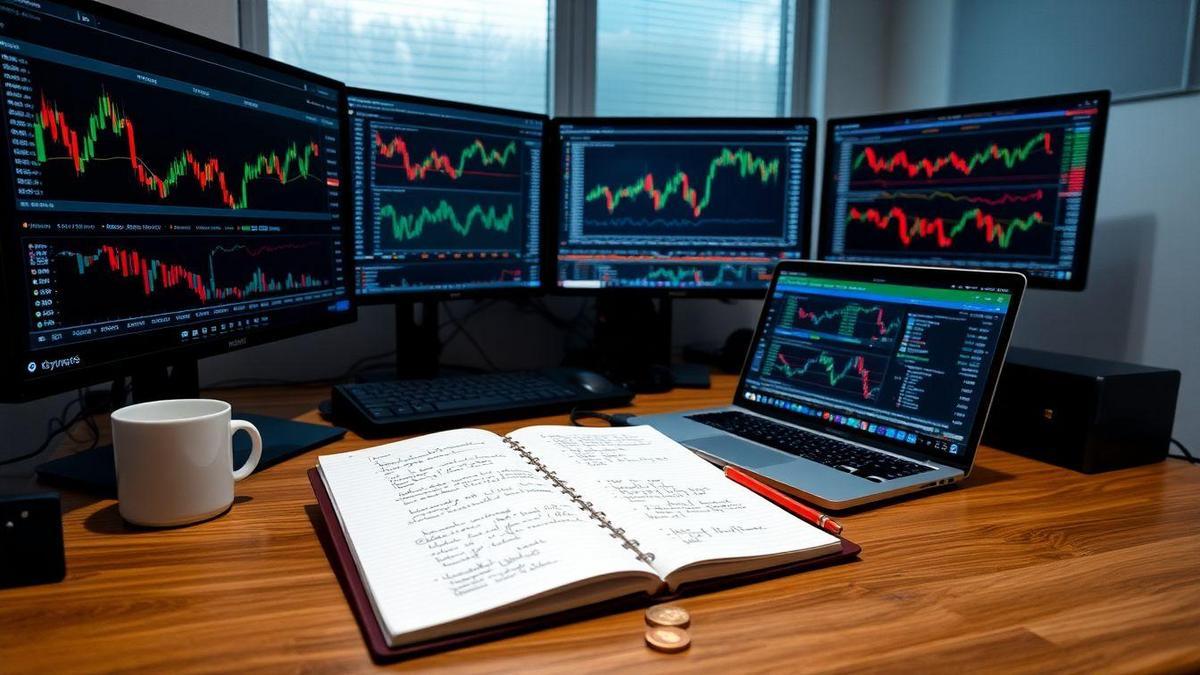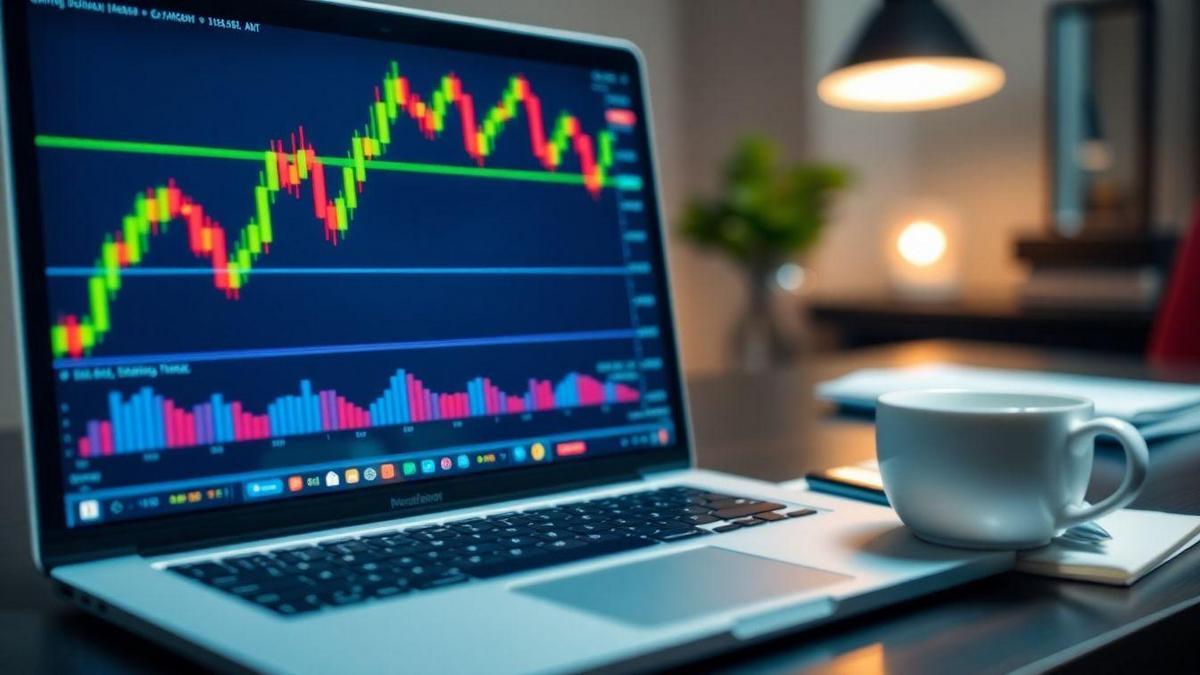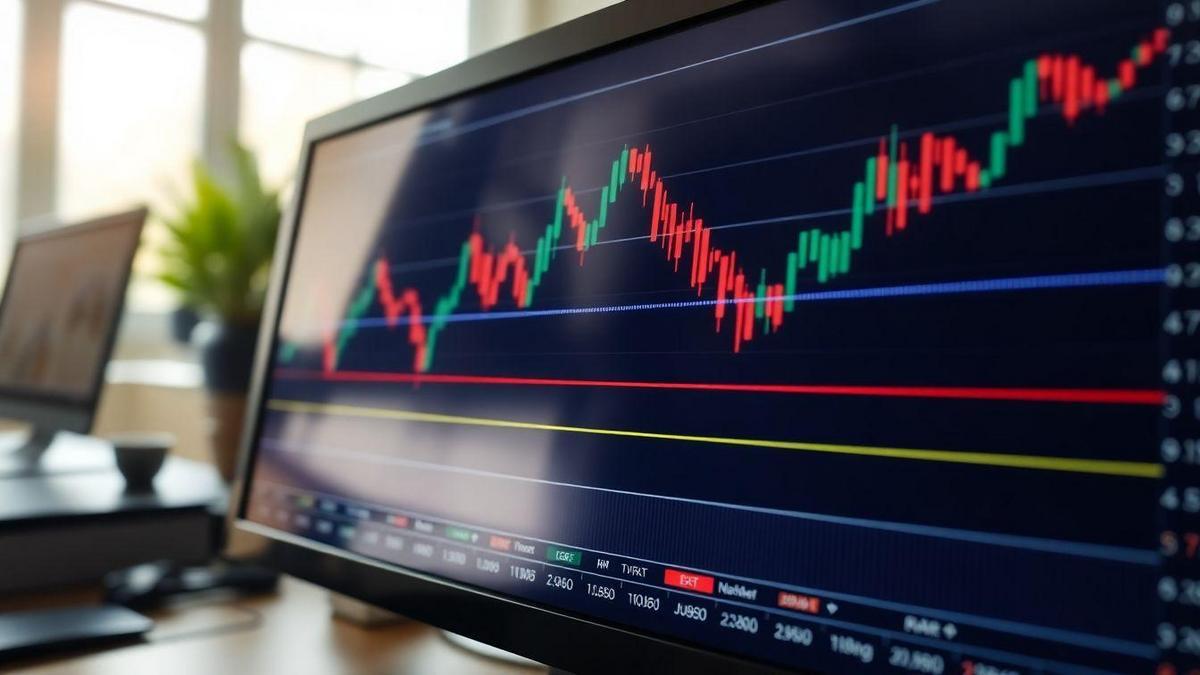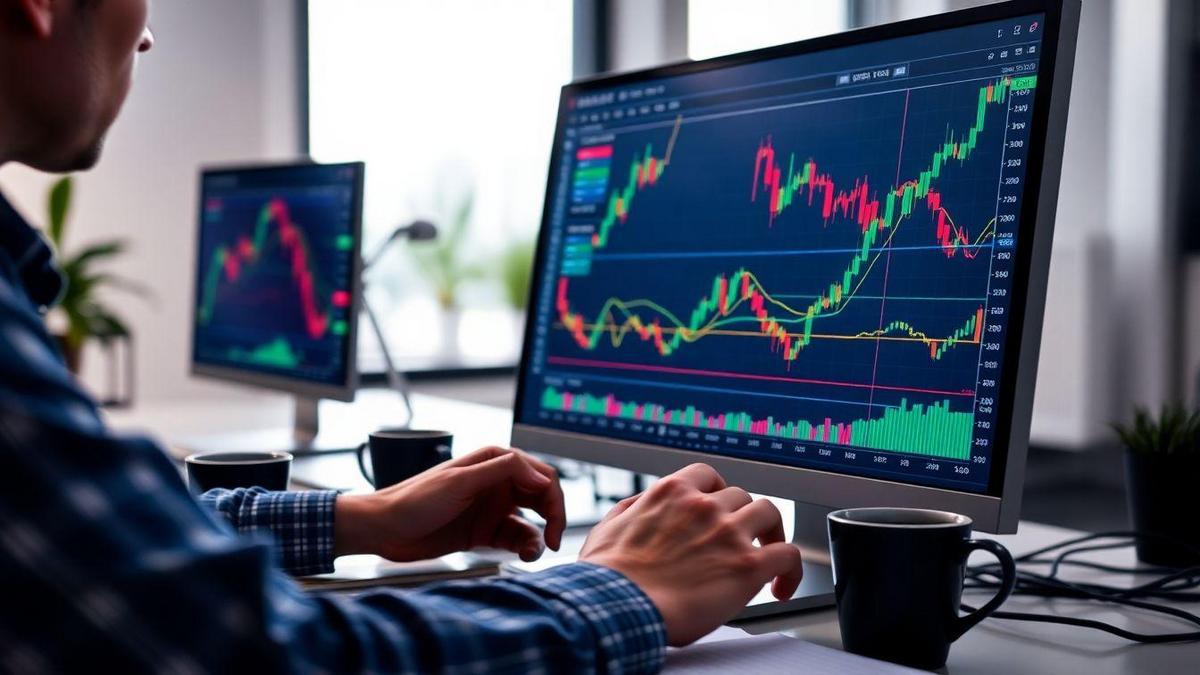Advanced Technical Analysis Techniques for Crypto Traders can seem tricky at first, but once you get the hang of it, you’ll feel like a pro! This article will walk you through the essentials of crypto trading. You’ll dive into market trends, candlestick patterns, and even the magic of Fibonacci retracement. Whether you’re just starting out or looking to sharpen your skills, you’ll find tips and tricks to help you make smarter trades. Ready to level up your trading game? Let’s get started!
Key Points to Remember
- Know your charts and patterns.
- Use indicators to spot trends.
- Manage your risks wisely. For insights on this, check out effective risk management strategies.
- Stay updated on market news.
- Practice makes you better.

Understanding Advanced Technical Analysis Techniques for Crypto Traders
What is Advanced Technical Analysis?
Advanced Technical Analysis is all about diving deeper into the charts and patterns of crypto markets. Instead of just looking at basic price movements, you focus on complex indicators and tools to make smarter trading decisions. Think of it like being a detective; you’re not just looking for clues on the surface but digging deep to find hidden trends and signals.
Why Use Advanced Technical Analysis Techniques?
Using these techniques can help you spot opportunities that others might miss. It’s like having a secret map that guides you through the twists and turns of the crypto world. Here are a few reasons to consider these techniques:
- Better Decision Making: You’ll make more informed choices based on data.
- Risk Management: Advanced tools can help you manage your risks better.
- Increased Profit Potential: Spotting trends early can lead to higher profits.
The Importance of Analyzing Market Trends
Analyzing market trends is crucial for any trader. It’s your compass in the ever-changing landscape of crypto. By understanding where the market is headed, you can position yourself to take advantage of price movements. Here’s why it matters:
| Reason | Description |
|---|---|
| Identifying Opportunities | Spot trends before they become obvious to others. |
| Timing Your Trades | Know when to buy low and sell high. |
| Understanding Market Sentiment | Gauge how other traders feel about the market. |
In the end, mastering Advanced Technical Analysis Techniques for Crypto Traders can give you the edge you need. It’s about being proactive, not reactive, and seizing the moment when it counts.

Key Market Indicators for Crypto Trading
What Are Market Indicators?
Market indicators are tools that help you understand how the crypto market is performing. Think of them as your compass in the vast ocean of cryptocurrency trading. They give you clues about whether prices are likely to go up or down. Some common indicators include price trends, volume, and market sentiment. By keeping an eye on these indicators, you can make more informed trading decisions.
How to Use Market Indicators Effectively
Using market indicators effectively is like having a map while hiking through the woods. You wouldn’t want to wander aimlessly, right? Here’s how to make the most of them:
- Combine Indicators: Don’t rely on just one indicator. Use a mix to get a clearer picture.
- Stay Updated: Markets change fast. Keep an eye on the latest news and trends.
- Practice Patience: Sometimes, the best move is to wait. Don’t rush into trades based on a single indicator.
Top Indicators Every Trader Should Know
Here’s a quick table to highlight some key indicators you should keep on your radar:
| Indicator | What It Measures | Why It Matters |
|---|---|---|
| Moving Averages | Average price over time | Helps smooth out price data |
| Relative Strength Index (RSI) | Measures speed of price changes | Tells if a currency is overbought or oversold |
| Volume | Number of trades | Indicates market activity |
| Bollinger Bands | Price volatility | Shows potential price movements |
These indicators are like tools in a toolbox. Each serves a purpose and can help you build a better trading strategy.

Candlestick Patterns in Crypto Trading
What Are Candlestick Patterns?
Candlestick patterns are visual tools that show price movements over time in the crypto market. Each candlestick represents a specific time frame—like a minute, hour, or day. The body of the candlestick shows the opening and closing prices, while the wicks (or shadows) show the highest and lowest prices during that time.
These patterns can help you spot trends and make informed decisions. They are like a story that tells you what traders are feeling. When you learn to read these patterns, you can better understand market movements and potential price changes.
How to Read Candlestick Patterns
Reading candlestick patterns is about understanding the colors and shapes. Here’s a simple breakdown:
- Green (or White) Candlestick: This means the closing price is higher than the opening price. It’s a sign of bullish (upward) sentiment.
- Red (or Black) Candlestick: This shows the closing price is lower than the opening price, indicating bearish (downward) sentiment.
To read them effectively, pay attention to the following:
- Length of the Body: A long body means strong buying or selling. A short body means indecision.
- Wicks: Long wicks can indicate that the price tried to go higher or lower but was pushed back, showing rejection of that price level.
Common Candlestick Patterns to Watch For
There are several key candlestick patterns to keep an eye on. Here are a few of the most common ones:
| Pattern Name | Description | Indication |
|---|---|---|
| Doji | The opening and closing prices are the same. | Market indecision. |
| Hammer | A small body at the top with a long lower wick. | Potential bullish reversal. |
| Shooting Star | A small body at the bottom with a long upper wick. | Potential bearish reversal. |
| Engulfing | A larger body completely engulfs the previous one. | Strong reversal signal. |
These patterns can provide you with clues about what might happen next. For example, if you see a hammer after a downtrend, it might mean that buyers are stepping in.

The Role of Trend Analysis in Crypto Markets
Understanding Trends in Crypto Trading
When you dive into crypto trading, understanding trends is like having a treasure map. Trends show you where the market is heading, helping you make better decisions. If you see a rising trend, it might be a good time to buy. On the flip side, a falling trend can signal it’s time to sell.
Trends can be short-term, lasting days or weeks, or long-term, stretching over months or years. Each type of trend has its own story to tell, and recognizing these can help you ride the waves instead of getting swept away.
How to Identify Market Trends
Identifying market trends is crucial for your success in crypto trading. Here’s how you can spot them:
- Price Movements: Keep an eye on how prices change over time. A consistent rise or fall can indicate a trend.
- Volume: Look at how much of a coin is being traded. High trading volume during a price increase can confirm a trend.
- Chart Patterns: Familiarize yourself with common patterns like head and shoulders or double tops. These can give you clues about future price movements.
Tools for Effective Trend Analysis
Using the right tools can make your trend analysis much easier. Here are some popular options:
| Tool | Description |
|---|---|
| Moving Averages | Smooths out price data to help spot trends. |
| Relative Strength Index (RSI) | Measures the speed and change of price movements. |
| Bollinger Bands | Shows price volatility and potential trend reversals. |
By leveraging these tools, you can make informed decisions in your trading journey.

Support and Resistance Levels Explained
What Are Support and Resistance Levels?
Support and resistance levels are key concepts in trading. Think of support as a safety net. It’s a price level where a stock or asset tends to stop falling and may bounce back up. On the flip side, resistance is like a ceiling. It’s where prices hit a wall and struggle to go higher.
Imagine you’re trying to push a ball down into a pool. The bottom of the pool is the support; the water pushes back when you try to go lower. Now, if you try to push the ball up out of the water, the surface tension is the resistance.
How to Identify These Levels
Identifying support and resistance levels can be simple if you know what to look for. Here are some tips to help you spot them:
- Historical Price Levels: Look at past price movements. If a price has bounced back from a certain point multiple times, that’s likely a support level.
- Trend Lines: Draw lines on your chart connecting the highs and lows. These lines can show you where prices may change direction.
- Moving Averages: These are averages of past prices. They can act as support or resistance, depending on the price’s position relative to them.
Here’s a quick table to summarize these methods:
| Method | Description |
|---|---|
| Historical Price Levels | Look for points where price reverses frequently. |
| Trend Lines | Connect highs and lows to visualize potential changes. |
| Moving Averages | Use averages to see where price may struggle. |
Using Support and Resistance in Trading Strategies
Now that you know what support and resistance are, how can you use them in your trading? Here are a few strategies:
- Buying at Support: If you see a stock hitting a support level, it might be a good time to buy. This is where prices often bounce back up.
- Selling at Resistance: If the price reaches a resistance level, it could be wise to sell. Prices often struggle to break through these levels.
- Setting Stop-Loss Orders: Place stop-loss orders just below support levels. This way, if the price breaks through, you can limit your losses.
- Breakout Trading: If a price breaks through a resistance level, it could signal a new upward trend. This is a great opportunity to jump in early.
By understanding these levels and using them in your trading strategies, you can make more informed decisions and potentially enhance your trading results.

Analyzing Trading Volume for Better Decisions
Why Trading Volume Matters
Trading volume is like the heartbeat of the market. It shows how many shares or contracts are being bought and sold. When you see high trading volume, it often means there’s a lot of interest in a stock or cryptocurrency. Think of it as a crowded party; the more people there are, the more exciting it feels.
Low trading volume, on the other hand, can be a red flag. It might mean that not many people care about that asset, which can lead to price swings that are hard to predict. So, keeping an eye on trading volume can help you make smarter decisions.
How to Analyze Trading Volume
Analyzing trading volume can seem tricky, but it doesn’t have to be. Here are some straightforward steps to help you get started:
- Look at Historical Volume: Check how the volume has changed over time. Is it increasing or decreasing?
- Compare with Price Movements: When the price goes up, does the volume go up too? This can show you if the trend is strong.
- Use Volume Spikes: Big jumps in volume can signal important news or changes in the market.
Volume Indicators to Enhance Your Strategy
To boost your trading game, consider these volume indicators:
| Indicator | Description |
|---|---|
| Volume Moving Average | This smooths out volume over a set time frame, helping you see trends more clearly. |
| On-Balance Volume (OBV) | This combines volume with price changes to show if money is flowing into or out of an asset. |
| Accumulation/Distribution Line | This indicator shows whether a stock is being accumulated (bought) or distributed (sold). |
Using these tools can help you spot trends and make better trading choices.

Fibonacci Retracement in Crypto Trading
What Is Fibonacci Retracement?
Fibonacci retracement is a tool that helps you understand price movements in crypto trading. It’s based on the famous Fibonacci sequence, where each number is the sum of the two before it. In trading, you use specific Fibonacci levels, like 23.6%, 38.2%, 50%, 61.8%, and 100%, to spot potential areas where the price might bounce back or reverse.
Imagine you’re on a roller coaster. As the ride goes up, you can guess where it might dip before climbing again. That’s what Fibonacci retracement does for prices. It helps you predict where the price might take a breather before moving in a new direction.
How to Use Fibonacci Levels
Using Fibonacci levels is pretty straightforward. Here’s how you can do it:
- Identify the Trend: First, look at the price chart. Is it going up or down?
- Select the High and Low Points: If the price is rising, choose the lowest point as your starting point and the highest point as your end point. If it’s falling, do the opposite.
- Draw the Levels: Use a Fibonacci retracement tool to draw lines at the key Fibonacci levels between your high and low points.
Here’s a simple table to help you visualize it:
| Fibonacci Level | Description |
|---|---|
| 23.6% | Minor support/resistance |
| 38.2% | Moderate support/resistance |
| 50% | Significant support/resistance |
| 61.8% | Strong support/resistance |
| 100% | Full retracement |
Once you’ve drawn these levels, keep an eye on them. If the price approaches one of these levels, it might bounce back or break through. This can be a great opportunity for you to make a trade.
Benefits of Fibonacci Retracement in Trading
Using Fibonacci retracement has several advantages for traders like you:
- Easy to Use: Even if you’re new to trading, Fibonacci levels are simple to understand.
- Helps Identify Entry and Exit Points: You can find good spots to buy or sell based on how the price reacts at these levels.
- Works in Different Markets: Whether you’re trading Bitcoin, Ethereum, or other cryptocurrencies, Fibonacci retracement can be applied.
In short, Fibonacci retracement is a handy tool that can help you navigate the crypto market with more confidence. By understanding where prices might change direction, you can make smarter trading decisions.

Moving Averages as a Trading Tool
What Are Moving Averages?
Moving Averages are a tool traders use to understand price trends. They help smooth out price data over a specific period. Think of it as a way to see the bigger picture. Instead of focusing on the daily ups and downs, you get a clearer view of the trend.
Types of Moving Averages to Consider
There are a few types of moving averages you might want to keep an eye on:
| Type of Moving Average | Description |
|---|---|
| Simple Moving Average (SMA) | This is the average price over a set time. It’s easy to calculate. |
| Exponential Moving Average (EMA) | This one gives more weight to recent prices, making it more responsive to new information. |
| Weighted Moving Average (WMA) | Similar to EMA but uses different weights for different prices. |
Each type has its own strengths. The SMA is great for spotting long-term trends, while the EMA can help you catch quick changes.
How Moving Averages Help in Decision Making
Moving averages can be your best friend when making trading decisions. Here’s how:
- Identify Trends: They help you see if the market is going up or down.
- Entry and Exit Points: You can use them to decide when to buy or sell. For example, if the price crosses above the moving average, it might be a good time to buy.
- Reduce Noise: They cut through the daily price noise, giving you a clearer signal.
Imagine you’re on a road trip. The moving average is like your GPS. It guides you through the twists and turns, helping you stay on track.

Utilizing Momentum Indicators for Success
What Are Momentum Indicators?
Momentum Indicators are tools used in trading to help you measure the speed at which a price is moving. Think of them as your speedometer in the world of trading. They show you how fast a stock or cryptocurrency is moving up or down. When prices move quickly, it can signal that a trend is strong, and that’s when you might want to jump in.
These indicators can help you spot potential reversals or confirm trends. They are crucial for traders who want to make informed decisions. You don’t want to be left in the dust, right?
How to Apply Momentum Indicators in Trading
Applying momentum indicators in your trading strategy is easier than you might think. Here’s a simple way to get started:
- Choose Your Indicator: Pick a momentum indicator that fits your style. Don’t worry; we’ll cover some popular ones shortly.
- Set Your Parameters: Adjust the settings based on your trading time frame. Short-term traders might use different settings than long-term investors.
- Analyze the Data: Look for signals. If the indicator shows a strong upward movement, it might be a good time to buy. If it’s dropping, you might want to sell or hold.
- Combine with Other Tools: Don’t rely solely on momentum indicators. Use them alongside other tools for a more complete picture.
Popular Momentum Indicators You Should Know
Here’s a quick table to help you understand some popular momentum indicators:
| Indicator | Description |
|---|---|
| Relative Strength Index (RSI) | Measures the speed and change of price movements. Values range from 0 to 100. A reading above 70 signals overbought, while below 30 signals oversold. |
| Moving Average Convergence Divergence (MACD) | Shows the relationship between two moving averages of a security’s price. It helps identify potential buy/sell signals. |
| Stochastic Oscillator | Compares a particular closing price of a security to a range of its prices over a certain period. Values range from 0 to 100. |
These indicators can be your best buddies in trading. They offer valuable insights and can help you make better decisions.
Conclusion
So there you have it! Advanced Technical Analysis Techniques for Crypto Traders can truly elevate your trading experience from novice to seasoned pro. By understanding market trends, candlestick patterns, and utilizing tools like Fibonacci retracement and moving averages, you’re not just playing the game—you’re mastering it! Remember, the key is to stay informed, practice regularly, and manage your risks wisely.
Just like a ship needs a compass to navigate through stormy seas, you need these techniques to guide your trading decisions. So, keep your eyes peeled for those market signals and don’t hesitate to adapt your strategies as the tides change.
If you’re hungry for more insights and tips to sharpen your trading skills, why not sail on over to Shop Financia for more articles? Happy trading!
Frequently Asked Questions
What are Advanced Technical Analysis Techniques for Crypto Traders?
Advanced Technical Analysis Techniques for Crypto Traders involve using charts, patterns, and indicators to predict market movements. They help you make informed decisions.
How do I start with advanced technical analysis for crypto?
You start by learning the basics first. Then move on to study different indicators like moving averages and RSI. Practice on demo accounts before trading with real money.
Do I need to be an expert to use advanced techniques?
Not at all! You can start using them with basic knowledge. Just take your time to learn and practice. Everyone starts somewhere!
What tools can help with advanced technical analysis?
You can use tools like TradingView, Coinigy, or Binance charts. These tools provide great graphics and indicators for easy analysis.
How do I make sense of complex charts?
Keep it simple! Focus on one or two patterns at a time. Use the tools and indicators to help. With practice, you’ll get the hang of it!